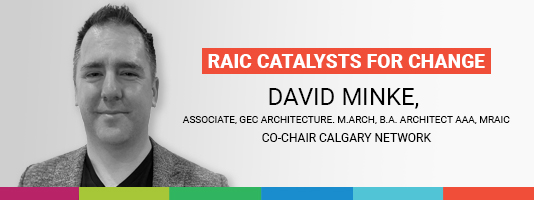
August 2024
To celebrate and honour RAIC volunteers, we are pleased to introduce you to David Minke, Co-Chair of the Calgary Network.
Thank you, David!
Q: Why did you decide to become an architect?
A: At first, it was a basic exposure to a drafting class that I had in grade 10. The first thing I remember drafting was a pool table. After that experience, I was hooked. It was so different from all the other subjects that I had experienced. Later in high school, I was involved in a fairly intense drafting and design class. While this experience was amazing, it left me with a wondering of how I can tap into my creative potential. During my undergraduate, I was exposed to the world of art, urban geography, sociology, math, statistics, and management. At this time, I was developing a portfolio in order to study architecture school. I had a fairly romantic view of architecture as unobtainable. After my undergraduate I travelled Europe for 3 months. Starting in Madrid and ending in Istanbul, filling three sketch books along the way. This was the classic “Grand Tour,” which at the time I knew nothing about. Then I entered architecture school. I was profoundly shocked at the vast differences between the art studio culture and the design studio culture. This is something that I still struggle with today. At this point, I keep my art practice separate from my architecture practice. My art practice is a way of overcoming my struggles within architecture. With art there is an intimate 1 to 1 relationship in the process of creation. As you are the person producing the design and the one implementing it. With architecture it takes such a long time from the act of creation to its implementation.
Q: How long have you been an RAIC member and what do you see as the value of your membership?
A: I have been an RAIC member for only a few years now. I’ve really enjoyed my time with the organization. It has provided a great opportunity to connect with like minded professionals who are typically outside of my realm of influence. I see the RAIC functioning on three different scales. First locally, nationally, and then internationally. I look forward to fostering all these realms in the Calgary Chapter.
Q: Why do you volunteer for the RAIC?
A: To reach beyond the boundaries of my company and build a supportive, inclusive architectural community.
Thank you RAIC for featuring me within this Catalysts for Change initiative. I am very honoured. I would also like to thank my fellow Calgary Chapter leadership team Alana and Tia. We make a good team. I think we will take Calgary by storm.
Q: What do you find most challenging about working as an architect?
A: Being separated from the act of creation. While at the same time being so integral to the process.
Q: Why is this area of advocacy important to you?
A: I feel our community has great potential to alter the course of our city’s future. Creating a collaborative and supportive community can allow for positive change.
Q: What do you think will most change/shape practice over the next five years?
A: Undoubtedly the use of Artificial Intelligence. It is growing and developing quickly with rapid investment. At the end of the day, it is still a tool that can be added to the skillset of the creative industries.
Q: What role do you see the RAIC and architects playing in terms of climate action, truth and reconciliation, and procurement reform, among other issues that matter?
A: Climate Action
Balancing the tradition holders and leapers to find a balanced way forward in regard to the energy crisis. Tradition holders believe our reliance on fossil fuels will never be altered and the leapers are suggesting systems that are challenging our current path. I believe that with conversation and open minds, there is a way to find alignment and opportunities to move forward together.
Truth and Reconciliation
I think RAIC could work with indigenous communities to better understand ways that we could contribute to increasing in the number of indigenous people entering the architecture profession. Starting with architecture schools and culminating in Indigenous lead practices.
Procurement Reform
I feel that we should be looking for ways to move forward with hyper collaborative project delivery models. Models which involve all parties early in the design process and through to completion. Integrated Project Delivery (IPD) is the first attempt at this initiative, but I think it will need refining as we go along.
Q: What do you like to do outside of architecture?
A: Play and watch basketball, connect with my neighbours, build forts with my two daughters, ride our cargo bike around the city and visit interesting communities within the city.
Q: What advice would you have for those looking to get more involved in advocacy causes related to architecture?
A: Be persistent, passionate, and collaborative. Throw long balls that you think are beyond your grasp. Check your ego.
Q: How do you incorporate diversity, equity and inclusion in your work environment, the built environment, and your volunteer work?



